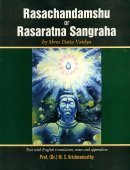Pushparaga, Puṣparāga, Pushpa-raga: 13 definitions
Introduction:
Pushparaga means something in Hinduism, Sanskrit, Marathi. If you want to know the exact meaning, history, etymology or English translation of this term then check out the descriptions on this page. Add your comment or reference to a book if you want to contribute to this summary article.
The Sanskrit term Puṣparāga can be transliterated into English as Pusparaga or Pushparaga, using the IAST transliteration scheme (?).
In Hinduism
Ayurveda (science of life)
Rasashastra (Alchemy and Herbo-Mineral preparations)
Source: Wisdom Library: Rasa-śāstraPuṣparāga (पुष्पराग, “Topaz”):—One of the nine gems (navaratna) according to the 13th century Rasaprakāśasudhākara. It also known by the name Puṣpaka (पुष्पक).
The Topaz (puṣparāga) has Pharmaco-therapeutic properties has possesses dīpana and pācana effects. It also destroys the following conditions:
- kapha-doṣa and vāta-doṣa,
- kuṣṭha-roga and chardi-roga (vamana).
It is highly recommended for the persons suffering from mandāgni, dāha (buring sansation), mūtrakṛcchra (difficulty in mituration) and it may be used by the persons in all times (seasons).
Superior: The Topaz is considered superior, and recommended for use, when the following properties can be described about the form of the gem: Clear, big (thick) and heavy in weight, having greasy surface, yellow in colour (like the flowers of karṇikāra), not titled or unstraight, smooth and soft.
Inferior: When possessed of the following characteristics, the Topaz is considered inferior and is not considered good for internal use and should not be given to brāhmaṇas also for dāṇa purpose: Dry and rough on surface, yellow, blackish, whitish, or orange coloured, dull in appearance, associated with doṣa (defects/bad characteristics) and without shining.
Source: History of Science in South Asia: Making Gems in Indian Alchemical LiteraturePuṣparāga (पुष्पराग) refers to “topazes” for which alchemical formulas are provided in order to create these gems, according to the Vādakhaṇḍa section of the Rasaratnākara (lit. “jewel mine of mercury”): a 13th century alchemical work in Sanskrit written by Nityanātha.—Verses 1-40 of chapter 19 continues with a series of formulations for creating gems. These formulations stand on their own and do not seem to be integrated into a larger alchemical programme of making mercurial elixirs. The gems to be created include [topazes (puṣparāga)], [...] None of the recipes for producing these gems are found in any other Sanskrit alchemical work.

Āyurveda (आयुर्वेद, ayurveda) is a branch of Indian science dealing with medicine, herbalism, taxology, anatomy, surgery, alchemy and related topics. Traditional practice of Āyurveda in ancient India dates back to at least the first millenium BC. Literature is commonly written in Sanskrit using various poetic metres.
Languages of India and abroad
Marathi-English dictionary
Source: DDSA: The Molesworth Marathi and English Dictionarypuṣparāga (पुष्पराग).—m S A topaz or Opal beryl?
Source: DDSA: The Aryabhusan school dictionary, Marathi-Englishpuṣparāga (पुष्पराग).—m A topaz or Opal beryl.
Marathi is an Indo-European language having over 70 million native speakers people in (predominantly) Maharashtra India. Marathi, like many other Indo-Aryan languages, evolved from early forms of Prakrit, which itself is a subset of Sanskrit, one of the most ancient languages of the world.
Sanskrit dictionary
Source: DDSA: The practical Sanskrit-English dictionaryPuṣparāga (पुष्पराग).—a topaz.
Derivable forms: puṣparāgaḥ (पुष्परागः).
Puṣparāga is a Sanskrit compound consisting of the terms puṣpa and rāga (राग). See also (synonyms): puṣparāja.
Source: Cologne Digital Sanskrit Dictionaries: Shabda-Sagara Sanskrit-English DictionaryPuṣparāga (पुष्पराग) or Puṣpajaga.—m.
(-ja or gaḥ) A topaz. E. puṣpa a flower, and rāga colour.
Source: Cologne Digital Sanskrit Dictionaries: Benfey Sanskrit-English DictionaryPuṣparāga (पुष्पराग).—m. a topaz, [Raghuvaṃśa, (ed. Stenzler.)] 18, 31.
Puṣparāga is a Sanskrit compound consisting of the terms puṣpa and rāga (राग).
Source: Cologne Digital Sanskrit Dictionaries: Cappeller Sanskrit-English DictionaryPuṣparāga (पुष्पराग).—[masculine] topaz.
Source: Cologne Digital Sanskrit Dictionaries: Monier-Williams Sanskrit-English DictionaryPuṣparāga (पुष्पराग):—[=puṣpa-rāga] [from puṣpa > puṣ] m. ‘f°-hued’, a topaz, [Varāha-mihira]
Source: Cologne Digital Sanskrit Dictionaries: Yates Sanskrit-English DictionaryPuṣparāga (पुष्पराग):—[puṣpa-rāga] (gaḥ) 1. m. A topaz.
[Sanskrit to German]
Sanskrit, also spelled संस्कृतम् (saṃskṛtam), is an ancient language of India commonly seen as the grandmother of the Indo-European language family (even English!). Closely allied with Prakrit and Pali, Sanskrit is more exhaustive in both grammar and terms and has the most extensive collection of literature in the world, greatly surpassing its sister-languages Greek and Latin.
Kannada-English dictionary
Source: Alar: Kannada-English corpusPuṣparāga (ಪುಷ್ಪರಾಗ):—[noun] a silicate of aluminum and fluorine, usu. containing hydroxyl and occurring in white, yellow, pale-blue or pale-green orthorhombic crystals, used as a gem.
Kannada is a Dravidian language (as opposed to the Indo-European language family) mainly spoken in the southwestern region of India.
See also (Relevant definitions)
Partial matches: Pushpa, Raga.
Starts with: Pushparagaprakara, Pushparakanilam.
Full-text: Pushparaja, Pushyaraga, Pushpa, Pushparakanilam, Putparakam, Pushkaraja, Pushpajaga, Purutarakam, Trinakuncaka, Gururatna, Pushparagaprakara, Pitarakta, Mayuranki, Topaz, Pushya, Punai Kannar, Nyasamantra, Vaijayanti, Ratna, Phussa.
Relevant text
Search found 13 books and stories containing Pushparaga, Puṣparāga, Pusparaga, Pushpa-raga, Puṣpa-rāga, Puspa-raga; (plurals include: Pushparagas, Puṣparāgas, Pusparagas, ragas, rāgas). You can also click to the full overview containing English textual excerpts. Below are direct links for the most relevant articles:
Rasa Jala Nidhi, vol 3: Metals, Gems and other substances (by Bhudeb Mookerjee)
Part 1 - Characteristics of Topaz (pushparaga) < [Chapter XXIV - Gems (14): Pushparaga (topaz)]
The Garuda Purana (by Manmatha Nath Dutt)
Chapter LXXIV - Tests of topas (puspa-raga) < [Agastya Samhita]
Chapter LXVIII - Description of the origin of gems in the treatise on Ratna Pariksa (test of gems) < [Agastya Samhita]
Cosmetics, Costumes and Ornaments in Ancient India (by Remadevi. O.)
1.2. Materials (f): Puṣparāga (Topaz) < [Chapter 3 - Ornaments]
The Bhagavata Purana (by G. V. Tagare)
Chapter 50(d) - Kṛṣṇa Crowned: Jarāsandha’s Defeat < [Book 10 - Tenth Skandha]
The Devi Bhagavata Purana (by Swami Vijñanananda)
Chapter 10 - On the description of Maṇi Dvīpa < [Book 12]
Chapter 11 - On the description of the enclosure walls built of Padmarāga maṇi, etc., of the Maṇi Dvīpa < [Book 12]
Guhyagarbha Tantra (with Commentary) (by Gyurme Dorje)
Introduction 1.2: The Ritual associated with the Coloured Lines < [Chapter 9 (Text And Commentary)]
Related products
